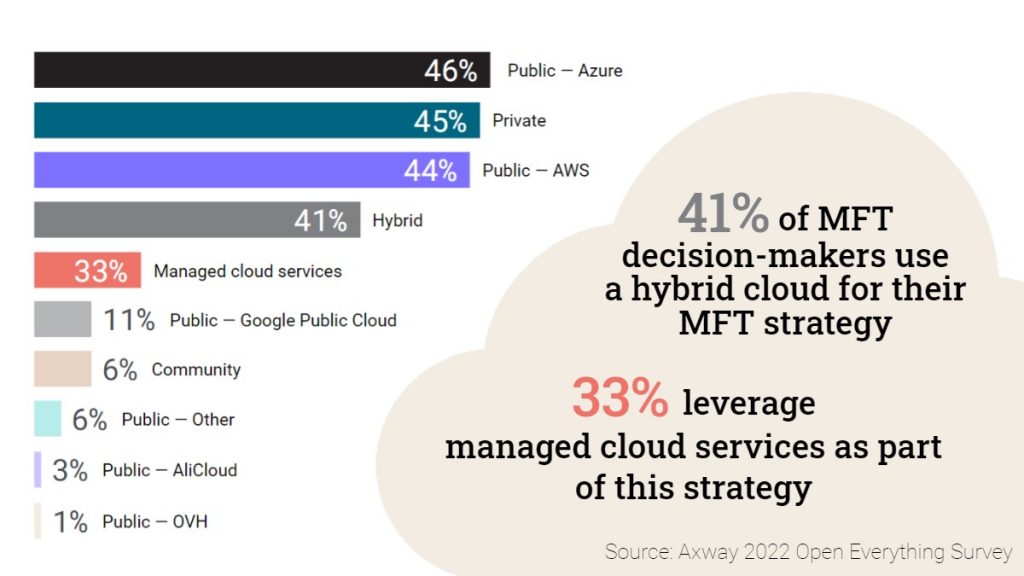It’s a question we’ve heard many times before: is managed file transfer on its way out?
The simple answer is no. Managed file transfer (MFT) has secured its place in today’s digital infrastructure where every company wants to make data more actionable. In fact, the use of MFT is increasing as more files are being exchanged each year.
We can see this continued growth play out in the transfer of:
- Patient records and large medical images in healthcare,
- Large CAD files and other technical documents in engineering and construction,
- Daily reconciliation of bank records for all customer transactions,
- Files for supply chain and inventory management between suppliers, manufacturers, and retailers.
At the same time, the dynamics around managed file transfer are evolving. There’s a tug-of-war between new versus old technologies, limited access to technical resources, and an emphasis on moving workloads to the cloud. These variables are reshaping the MFT conversation, and Axway is supporting customers through this shift.
The balance of old & new technologies
APIs have changed the way companies do business. Think about an online retailer as an example; files are exchanged on the backend systems to secure a large volume of transactions between buyers and sellers.
They might leverage dozens of APIs to enhance their customer experience, from integrated payment methods to smartphone alerts about current sales based on past purchases, to real-time status updates on the shipment via the retailer’s website.
While the retailer reaps benefits, the same goes for the API providers that monetize their data. In today’s digital infrastructure, MFTs and APIs continue to coexist, with each serving its distinct purpose.
We need to consider that it’s not about one replacing the other, but it’s more about interconnecting what you will be doing with MFT today and what you will be doing tomorrow with APIs.
See also: 3 steps to take now to future-proof your managed file transfer operations
At the same time, there are other groundbreaking technologies in play — and Axway is helping to bring these together with MFT to drive powerful innovation.
One of the main suppliers of power lines in California relies on MFT to capture and transfer real-time images that show the state of power lines. The information gathered is treated through a machine learning-based system that notifies personnel of incidents so they can take action.
This mix of old and new technologies ensures no information is lost in the process, helping prevent the catastrophic consequences of fires that can occur if power lines come into contact with trees.
Fewer resources to maintain systems
The effects of the Great Resignation have been felt across all industries, but one of the hardest hit is IT. In a 2021 IT Skills and Salary Report from Global Knowledge, 76% of IT decision-makers said they were experiencing critical skill gaps in their teams. That’s a 145% increase from 2016.
These talent shortages have left companies in a bind where they have to give professionals more job incentives, often in the form of higher salaries or better benefits. But when you’re dealing with B2B IT systems founded decades ago, there are more layers of concern for businesses.
Older B2B IT systems tend to be more outdated, unreliable, defragmented, and costly to maintain than their modern counterparts — with the end-of-life cycle making things even more complex. What’s more, younger professionals aren’t typically very interested in dealing with heritage IT.
This translates into more complexity and work for IT teams when there is a lack of technical resources at a company’s disposal.
Good reason to move to the cloud(s)
There is a consensus around the value of migrating workloads to the cloud — more scalability, fewer costs, and less maintenance (to name a few). But every company has its reason for making the move.
Time to market is often a strong incentive. For Bpifrance, a public investment bank backed by the government, the push came from a need to support small- and mid-sized companies in France with financial support during the COVID-19 pandemic.
They had three months to set up a fully operational, large-scale MFT environment that could handle numerous application requests for financial support. They achieved that with Axway Managed Cloud Services.
Moving to the cloud should in fact read moving to the clouds — plural. Hybrid cloud is the norm these days, which leads back to the scarcity issue of technical resources to implement the right choices.
In Axway’s 2022 Open Everything Strategy Survey, one question asked of 1,000 IT leaders, architects, and developers was the type of cloud services they used for their MFT and API operations.
The results show variety on this front. 41% of businesses said they use a hybrid cloud for their MFT strategy, with 33% leveraging managed cloud services as part of this strategy.

It’s not one cloud environment; it’s many cloud environments; this is the reality we’re in.
So, buckle up and let us help you prepare for the next age of MFT in the cloud.
Join us for a webinar on crucial steps to safeguarding your customers.


